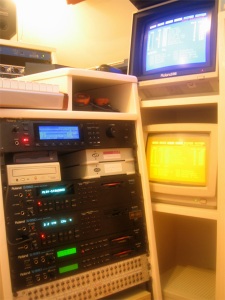The JX-10 is my favorite analog synth for pads and synthstrings and it also does a good job for leads and basses. The thing is (or was) that it was almost impossible to edit the sounds in realtime without the PG-800 programmer. The only way was to look up one parameter at a time in the menu and then turn the Alpha-dial wheel a thousand times to get the sound where you wanted it to be, a lot of button pushing and wheel turning! The MIDI implementation was a disaster but luckily Colin Fraser rewrote the sysex code for the JX-10, so now it can communicate with MIDI editors/controllers, DAW’s, etc… I still got a copy of Emagic SoundDiver, and I was able to program the JX-10 using a modded JX-8P preset and MKS-70 preset, but it wasn’t really stable. Another downside was that it couldn’t be controlled in real-time in combination with Logic Pro, so I decided to give a try and build a JX-10 editor in Logic’s Environment. Last time I used the Environment was almost 15 years ago, my programming skills are very limited, so don’t expect the editor to be a work of art! I only used faders, no knobs for switching the waveforms, there’s no reading of value’s in the editor, but luckily the JX-10 display tells you what you are doing.
In fact, I build 2 versions of the editor, one that only reacts when moving the virtual faders in the Environment and one that can be controlled by a hardware MIDI controller, in my case the assignable control faders on the Kurzweil K2500. With my limited skills I couldn’t combine those two into one version without very noticeable artifacts (sloppy timing when using more than one fader at one), but you can combine them both. That’s how I use it, because I can only automate 32 parameters of the virtual controller with the K2500, the ones that aren’t controlled by the K2500, can be controlled in Logic by hand that way . Now I can record all changes made in the sound into Logic in real-time, just like you would do when using a plug-in, but now it sounds good too
You can look at the JX-10 as two JX-8P’s in one box, it has literally two JX-8P boards in it. Another thing they didn’t get right at Roland at the time is the way the JX-10 saves it’s sounds. One sound (called patch) build out of 2 tones (1 tone=1 JX-8P). Those tones can be used in more than one sound (patch). So if you save a tone in one patch, other patches using that tone will also change….. If you got the M-64C memory cartridge you can do sysex dumps, so that would be a wise thing to do before you starts messing up great patches. Being two 8p’s, you can only edit one tone at the time, not a big thing if you’re only editing a sound, but if you’re recording the sysex changes, it would have been way cooler if it could handle both tones at the same time. But still better than turning the Alpha-dial and not recording sysex at all!
I really like the sound of the JX-10, while creating the editor I finally heard the full sonic power of the JX-10. Sometimes you read that people find the JX too slow for basses, but with a few tweaks in the editor I got punchy basses with a lot of weight. It’s so much easier now to get the sounds you want.
I’d be happy to share the JX-10 environment with you. I think you can also use it with the MKS-70 module version of the JX-10 and if you can change sysex code yourself, you can also use the JX-8P (change the 3rd hex nr “36” into “35”, change sysex view into hex). The JX-10 MUST be upgraded with the rewritten sysex code, version 2.3 (latest version) in order to work.
If you want to program your MIDI controller, please check the “JX-10 CC info” file for the CC numbers.
If you’re a Kurzweil K2500 user you can load the “MIDI_SET.K25” master file into your machine, then all 4 fader banks are automatically ajusted with correct MIDI channel and CC number settings.
Click HERE to download



